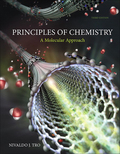
Concept explainers
Interpretation: The electronic configuration for each of the given elements is to be stated.
Concept introduction: The electrons of an atom or molecule are distributed in molecular or atomic orbitals. This distribution of electrons is known as the electronic configuration of the atom or molecule.
To determine: The electronic configuration for each of the given elements.
Answer to Problem 8.1P
Solution: The electronic configuration of
(a)
Explanation of Solution
On basis of the periodic table of elements, the atomic number
So, chlorine has
The electronic configuration of element
Where,
(b)
Atomic number is the total number of electrons present in a neutral atom.
On basis of the periodic table of elements, the atomic number
So, silicon has
The electronic configuration of element
Where,
(c)
Atomic number is the total number of electrons present in a neutral atom.
On basis of the periodic table of elements, the atomic number
So, strontium has
The electronic configuration of element
Where,
(d)
Atomic number is the total number of electrons present in a neutral atom.
On basis of the periodic table of elements, the atomic number
So, oxygen has
The electronic configuration of element
Where,
Want to see more full solutions like this?
Chapter 8 Solutions
Principles of Chemistry: A Molecular Approach (3rd Edition)
 ChemistryChemistryISBN:9781305957404Author:Steven S. Zumdahl, Susan A. Zumdahl, Donald J. DeCostePublisher:Cengage Learning
ChemistryChemistryISBN:9781305957404Author:Steven S. Zumdahl, Susan A. Zumdahl, Donald J. DeCostePublisher:Cengage Learning ChemistryChemistryISBN:9781259911156Author:Raymond Chang Dr., Jason Overby ProfessorPublisher:McGraw-Hill Education
ChemistryChemistryISBN:9781259911156Author:Raymond Chang Dr., Jason Overby ProfessorPublisher:McGraw-Hill Education Principles of Instrumental AnalysisChemistryISBN:9781305577213Author:Douglas A. Skoog, F. James Holler, Stanley R. CrouchPublisher:Cengage Learning
Principles of Instrumental AnalysisChemistryISBN:9781305577213Author:Douglas A. Skoog, F. James Holler, Stanley R. CrouchPublisher:Cengage Learning Organic ChemistryChemistryISBN:9780078021558Author:Janice Gorzynski Smith Dr.Publisher:McGraw-Hill Education
Organic ChemistryChemistryISBN:9780078021558Author:Janice Gorzynski Smith Dr.Publisher:McGraw-Hill Education Chemistry: Principles and ReactionsChemistryISBN:9781305079373Author:William L. Masterton, Cecile N. HurleyPublisher:Cengage Learning
Chemistry: Principles and ReactionsChemistryISBN:9781305079373Author:William L. Masterton, Cecile N. HurleyPublisher:Cengage Learning Elementary Principles of Chemical Processes, Bind...ChemistryISBN:9781118431221Author:Richard M. Felder, Ronald W. Rousseau, Lisa G. BullardPublisher:WILEY
Elementary Principles of Chemical Processes, Bind...ChemistryISBN:9781118431221Author:Richard M. Felder, Ronald W. Rousseau, Lisa G. BullardPublisher:WILEY





